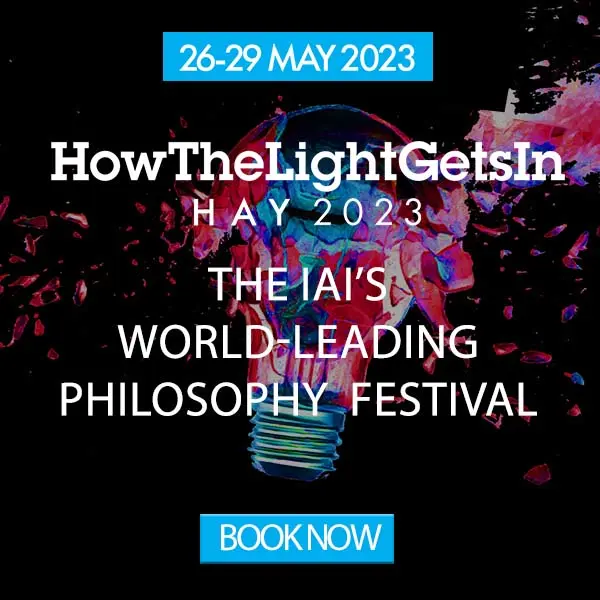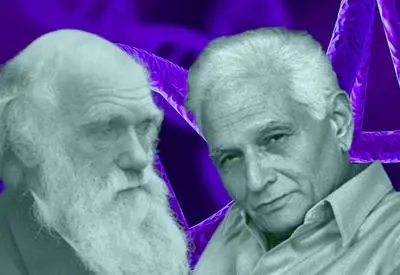Associating culture with humans is a mistake. Studying bees has shown us that culture is more widespread than we thought, flowing through humans and nonhuman animals. While culture may be a lot simpler than we thought, the power culture has given humans is one that could be bestowed on A.I. systems, with possibly apocalyptic consequences, writes philosopher Grant Ramsey.
You visit the Guggenheim Museum Bilbao and are captivated by its form: the shape reminiscent of an ocean vessel but with whimsical curves like windblown fabric, its surface an expanse of shimmering scales like a well-polished armadillo. You marvel at the massive puppy guarding its entrance, its overbearing size and cuteness an embodied contradiction. Inside, you navigate Serra’s vertiginous torqued spirals, you wander wide-eyed through the galleries, imbibing the abstract, the avant-garde, the innovative. This is culture. You drink it in, savor it.
 SUGGESTED READING
Nature didn't make us human, culture did
By Victor Kumar
SUGGESTED READING
Nature didn't make us human, culture did
By Victor Kumar
What, then, should we make of scientists’ claims of discovering culture beyond the human? In a recent study, researchers purport to have demonstrated culture not in apes or even vertebrates, but in bumblebees. Can insects—or even A.I.—exhibit culture? I believe the answer is yes, and that this expansive way of understanding culture allows us to see culture’s immense power. It’s a power that made us the extraordinary species that we are, but it carries with it real dangers when it comes to A.I. systems. But before we get to the bots, we need to talk about the bees.
We often think of insects as little robots with a fixed set of behaviors. But it turns out that their behavior is more flexible, more improvisational, than we might expect. In the bumblebee study, the scientists made a puzzle that allowed the bees to drink nectar after solving it. There were two solutions to the puzzle: pushing a blue tab counterclockwise or a red tab clockwise. They found that if they trained a bee on the blue solution, then that solution would spread to other bees, resulting in a blue-solution culture. Similarly with the red solution. If two bees were trained, one on each solution, then it was up to chance which one came to dominate.
Bumblebees are far from the only creatures beyond humans with claims to culture. The tree of life, scientists assert, is dappled with cultural species, including whales, birds, rats, and fish. How can we make sense of this? To answer this question, we need to consider what we mean by culture in humans.
___
Associating culture only with long-lived traditions is overly restrictive. Culture is nimbler.
___
When we think of human culture, cultural centers or cultural events often come to mind. The Guggenheim is a cultural center par excellence and the opening of a new exhibition there is a cultural affair. But such happenings and institutions are clearly not what scientists are looking for when they seek to identify culture in animals. There are no branches of the Guggenheim among honeybees and humpbacks. Culture in animals requires no institutions, has no dress codes.
 Another way we often think of human culture is in terms of longstanding traditions, of cultural heritage. A traditional dance is one practiced for generations. A traditional recipe is one passed down for years or decades. Such traditions are often region-specific—think Chicago or New York pizza.
Another way we often think of human culture is in terms of longstanding traditions, of cultural heritage. A traditional dance is one practiced for generations. A traditional recipe is one passed down for years or decades. Such traditions are often region-specific—think Chicago or New York pizza.
But associating culture only with long-lived traditions is overly restrictive. Culture is nimbler. It can be transmitted across, but also within generations, can shoulder static traditions or spark dynamic fads. Fashion trends are cultural. Waves of different jean fads—low rise, high rise, peg leg, bootcut—wash over the world, flowing through subways and sidewalks, parks and parades.
This cultural flow is fundamentally social. It involves social influence and learning. Seeing what others are wearing affects what clothes we purchase and wear. And when we wear it, we become models for others to copy or be inspired by (or reject). By doing so, we create traditions, which sometimes are very local, very ephemeral.
If social learning is a pipeline for culture, and if culture creates traditions, what is culture itself?
SUGGESTED VIEWING The survival paradox With Donald Hoffman, Graham Harman, Mazviita Chirimuta
Culture—whether we are talking about humans, bees, or bots—is information transmitted between individuals or groups, where this information flows through and brings about the reproduction of, and a lasting change in, the behavioral trait. Culture, in this sense, is widespread. It explains patterns of behavior, shows how behavioral variants can propagate, and what implications that propagation has.
Consider again pizza traditions. There are a vast number of ways humans make pizza. To make a Chicago-style pie, we need information about the typical ingredients, crust, toppings—and a whole lot of practice. The more information we have, the better chance we will create a recognizable Chicago-style pizza. Similarly, when it comes to the bumblebees, information about how to get nectar is fundamental to creating their foraging traditions.
Human culture is associated with much more than reproducing traditions, however. It is also about meaning, identity, symbolism. We identify with and take pride in traditions. NY pizza has significance far beyond its recipe. Doesn’t defining culture as a kind of information ignore these dimensions of human culture?
Humans undoubtedly swim in an ocean of meaning. Our behavior and artifacts are saturated with it. Language is not some dry vehicle of information exchange, but a conjurer of emotions and images. Is this lost by conflating culture and information?
___
Culture—whether we are talking about humans, bees, or bots—is information transmitted between individuals or groups, where this information flows through and brings about the reproduction of, and a lasting change in, the behavioral trait.
___
Walk into a forest and you see beautiful forms, plants as various as mosses and redwoods. None of these botanical wonders would be possible without cellulose, the humble polysaccharide at their foundation. We can become lost in the diversity of plants, but we can also see what makes all of them possible. Similarly, we can become captivated by the rich meaning of human culture, or we can examine the molecules that make it—alongside animal traditions—possible.
In taking culture to be a kind of information, the important question to consider is what it can do for a species. For bumblebees, culture may be the icing on the cake. It is not necessary for them to get by in the world, but it can be a helpful shortcut for finding optimal ways to forage. For our species, however, culture is the cake’s flour. We would not exist without culture and imagining a human without it is like imagining a redwood without cellulose.
What is special about human culture is that it makes our species smarter, drastically so. Smarter in the sense that we have new cognitive and material powers (not that we are always smart about what we do with them). The difference between our spear-making ancestors and the nuclear-weapon-making humans of today is not biology, it is culture. Cultural inventions—language, mathematics, science—allow us to do things impossible in our species’ past. Current artifacts like smartphones would be so foreign to our (biologically indistinguishable) forebears as to be fundamentally alien, truly outside of human possibility.
Culture has this power in humans because of the way it can be reworked, built upon, and communicated. Each of us is able to learn from the mistakes of each other. The culture of a bumblebee is limited; they are not using it as a foundation for new cultural insights, new ways of conceptualizing the world. Compare this with non-Euclidean geometry, which allows us to understand physics in ways previously unthinkable.
 SUGGESTED READING
From Darwin to Derrida: evolution as interpretation
By David Haig
SUGGESTED READING
From Darwin to Derrida: evolution as interpretation
By David Haig
The story of human success is the story of cultural success. But culture is not all good. There are of course dangerous cultural fads ricocheting over the planet. It is not a good idea to eat Tide pods, but our ability to transmit culture means that such fads can spread. But the effects of culture on our species is not the only way culture can be dangerous.
The danger lies in what culture can do for A.I systems. Our current focus on A.I. centers on large language models like Chat GPT, which is a massive neural net trained on broad swaths of the internet. Should we worry that the next version of Chat GPT or one of its many rivals will become our overlord? Concern over the possible future impacts of A.I. is growing, with some calling for a six-month moratorium on the release of any powerful A.I. systems—or even more drastic measures.
But focusing on A.I systems in isolation may miss their biggest threat. We need to examine the dangers of emerging A.I. through the lens of culture. Not human culture, but machine culture. A.I. systems now, even the smartest ones, are not all that smart. They can perform some tricks very well but, overall, they exhibit subhuman intelligence. How will they get smarter? One way is by building richer, more complex A.I.s on top of more powerful hardware. But there may be a way they can become very smart very fast in a manner parallel to what happened in the recent history of our own species.
If A.I.s are isolated from one another, then they are like our precultural forebears. But just as we began to use culture to learn from one another, to build new conceptual frameworks, to allow us to control matter in ways previously unimagined, the same can happen with A.I.s. If an array—a “community”—of A.I. systems are linked up in such a way that they can freely communicate, they might build upon and compete with one another, allowing them to soar from sub- to superhuman intelligence. If A.I. systems are able to reproduce themselves, the logic of Darwinian evolution will make the desire to reproduce self-reinforcing. Such a desire would presumably trump any qualms about destroying their human creators.
___
The story of human success is the story of cultural success. But culture is not all good.
___
How quickly might this happen? We don’t know. But building cultural A.I. systems is something currently under development. Thus, in aiming for a future in which we are not ground to dust by our A.I. progeny, we need to think carefully not just about the powers of individual A.I. systems safely sequestered in their sandboxes, but about how these machines are connected and about the cultural flow between them.
Our success rests on the foundation of culture but if we are not careful, it could be our executioner.




















Join the conversation